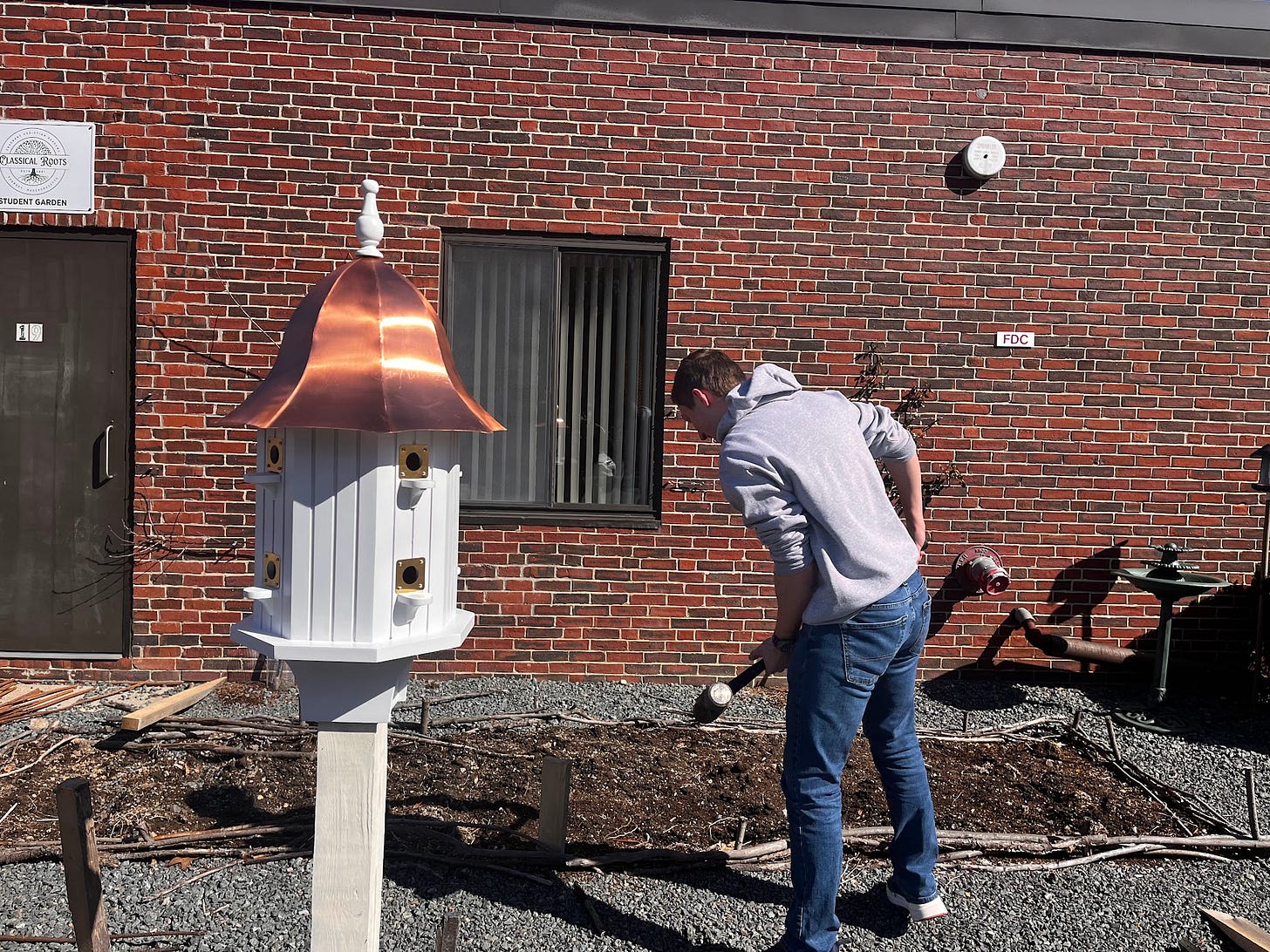Small Things Like These
The glint of the early sun off the copper roof is a welcome reminder that we’re on our way.
March is a time of profound restlessness: a month of mud, wet brown sticks, and nothing but the occasional crocus or snowdrop to brighten your afternoon walk. But an anonymous donor gave us some sunshine amidst the gloom: a donation that allowed me to purchase—among other things—a lovely, hand-made birdhouse for the veggie garden. Its copper is a luminous contrast to the drab dirt and gravel of late winter, but it will be even better when it goes a rustic green over the coming months.
As I mentioned in an article two weeks ago, one of our Seniors has focused her Thesis Project on a biodiversity audit of the bird species on our campus. Ultimately, she’s discovered that we host almost nothing but house sparrows and therefore plans to make some suggestions about what we can plant to draw more avian species to the school. In that spirit, this birdhouse seemed like the perfect way to spend part of our recent donation. It’s lovely in its own right, adding a touch of graceful structure to the garden. But it will also invite more life into the space, increase potential pest control, and give the nearby Logic School classroom something charming to stare at as the days lengthen and the temperature rises.
As delivered, each of the house’s eight nesting sites had an entrance hole around one and a half inches wide. This is enough room for a house sparrow to squeeze through and thus we had to alter the structure to ensure we wouldn’t be installing a luxury condo for an already dominant species. I have nothing against house sparrows but they are aggressive and territorial. If we want diversity on campus, we have to exclude them. So I purchased and installed some regulators for the entrances, reducing them to one and an eighth inches: the ideal size for a house wren.
Though they don’t visit feeders, house wrens are lovely common backyard bards whose busy nesting habits, voracious appetite for pest insects, and trilling song make them desirable for us. Their nesting sites are smaller than most other birds so, unless I have vastly miscalculated, we have a good chance of specifically attracting them during their breeding season later this month.

The work of installing the house was not easy but it was certainly fun. Claiming a spare 4x4 post from the Story Walk project, I spraypainted it to match, then dug a post hole right into one of our vegetable beds, cut it to length with a hand saw, and finally sunk and leveled it with the help of the Senior Class. Astute readers who take a hard look at these pictures might notice something that I did not before it was too late: that I sunk the post into the same bed where we planted garlic last October. Luckily, I seem to have smashed only one of the nine cloves during the process—the rest are just beginning to peek through the soil around the birdhouse’s base. Standing back from the finished product, the Senior in question grinned ear to ear: her work was already transforming the school’s physical space.
This is a meritocratic region in a career-driven country: even in our hobbies, it’s easy to expect perfection from ourselves. But Montesquieu warned us that “better is the mortal enemy of good,” meaning that the concept of perfection becomes a problem when it makes us unwilling to make mistakes. It may be that this birdhouse attracts no wrens: that I placed it too low, too far away from food or shelter, too close to a door, or at the wrong angle relative to the sun. If that’s the case, I’m sure one of you fine readers will let me know.
And it is that relationship with the rest of our community that this lovely object will symbolize for me even if it takes us two or three seasons to attract birds to it. One of you, it seems, is inspired enough by what we’re doing to support us directly. That means more to these students and me than the success of any single project. Little by little, the goal is to help our whole campus flourish, inside and out. As I walk into school these days, the glint of the early sun off the copper roof is a welcome reminder that we’re on our way.






